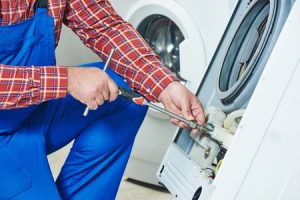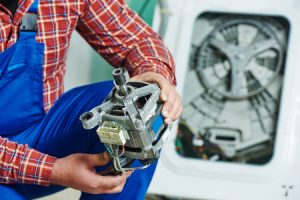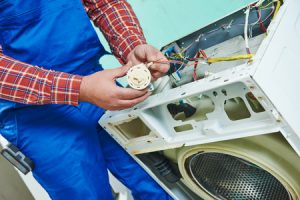
Pump Set
The primary function of the drain pump is to pump water from the wash tub during and before the spinning cycle. The pump of the washing machine is motor driven, belt driven or may have its electric motor. If you hear sound during or after the spinning cycle, it indicates that drain pump is defective.
To locate the pump, you must remove the cabinet or front panel of the machine. Be extremely careful when removing these parts, as you may be exposed to electrical circuits and moving parts. Before checking the condition of the pump, disconnect the power supply to the machine and remove the inlet hose. At times, eliminating foreign objects from the pump set will solve the problem. If a part is worn out or damaged, replace the part immediately and tighten the hose clamps. If this does not address the problem, it is best to call a washer service technician.
Drive Belt
Some top-loading washing machines use the drive belt to connect drive motor to the transmission. In front loading machines, the drive belt is used to connect the drive motor to the wash basket. Most washing machines you use in your home have multi-rib or V-shaped drive belt made of rubber. If the drive belt is damaged or worn out, you must replace it.

Some washing machines use motor drive coupling to transfer power from the engine to the transmission. The drive coupling consists of two drive forks with a rubber coupling between the forks. One fork is attached to drive motor shaft and the other to the transmission input shaft. When the shaft motor rotates, the rubber coupling between the forks absorbs the torque to prevent the drive forks from breaking.
Regular use of the washing machine can damage the coupling, which can cause the forks to slip and make a vibrating noise. If the spin basket cannot turn freely or the transmission seizes, it indicates the coupling has failed. Most washing machine models will require you to remove the cabinet or the machine to access the drive coupling. Before attempting any repair, make sure you disconnect the power supply to the device.
Shock Absorbers
Washing machines have shock absorbers that dampen the tub movement in the machine spin cycle. These shock absorbers are usually attached to the outer tube and the base frame. To access these shock absorbers, you must remove the front or the rear panel. When shock absorbers are damaged or worn out, the machine will make loud noises. If the symptoms are not corrected, it can damage other parts of the washer. If the shock absorbers are damaged, you must take steps to replace them immediately.
Tub Dampening Strap
Some machines come with tub dampening straps that cushion the movement of the wash tub during the spin cycle. Most models have four straps that attach the wash tub to the four corners of the machine. Since these straps are made of rubber, they can get damaged due to excessive use. At times, the straps may get damaged when residential users overload the machine. When the straps are damaged, you can hear loud banging sound when the tub rotates. To solve this problem, you must raise the top of the machine to check the condition of the strap. If even a single strap is damaged, it is best to replace all the four straps at the same time.
Drive Motor
On a top loading machine, the drive motor is used to spin the wash basket and to operate the transmission and pump. If you use a front load washing machine, the drive motor is used to run the belt that controls the operation of the wash basket pulley. One of the symptoms of failing drive motor is a buzzing or humming sound when the machine starts. Identifying the exact cause of the problem in the drive motor is not easy. You will need several tools to analyze and rectify the problem. It is in your interest to use the services of the washing machine service technician to correct the problem.
Pulley

Pump Belt
The pump belt of the machine drives the pulley of the drain pump. Age and regular use of the pump belt can cause it to become frayed or cracked, which can create a thumping or squeal sound during the spin or drain cycle. This may be accompanied by an incomplete drain or burning rubber smell. Check the belt for signs of abrasion, overheating, or wear and tear. If the belt is damaged, you must replace it with the exact replacement belt. Using the wrong belt can damage other parts of the machine.
Tub Bearings
These bearings allow the inner tub or wash basket to rotate freely. Most top loading washers have a bearing at the point where the shaft is attached to the inner tub and another at the bottom of the tub. The tub seal protects the bearing from the wash water. Regular use of the machine can cause the seal to break down, allowing the water to enter the bearing and eventually damaging it. If you hear a roaring or rumbling sound in the spin cycle, it usually indicates the failed tub bearing. Replacing a damaged bearing is not easy. To solve this problem, it is best to get help from a washer technician.
Clutch Assembly
The clutch assembly helps in locking the transmission input shaft to the wash drive during the spin cycle. Repeated friction of the clutch can cause it to wear and create a scraping sound. When the clutch is damaged, it prevents the machine from spinning. You may also notice loud noise or burning smell during the spinning cycle when the clutch is damaged. If your appliance displays any of these symptoms, you must visually check the clutch for signs of damaged. You can find the clutch below the outer tub, and it is attached to the driving basket. To access the clutch, you must remove the cabinet, drive motor, and transmission assembly.
Other Locations We Service In Popular Cities:
Henderson, Manchester, Philadelphia dishwasher servicemen, dishwasher repair San Diego CA, New Haven dishwasher appliance repair, Chicago, Kansas City, Virginia Beach, Fort Worth, San Francisco dishwashing machine service, Atlanta kicthen appliance repair, Jacksonville dishwasher service, Albuquerque, Seattle, Tampa, Detroit, San Antonio, Colorado Springs, Lakewood, Allentown, Orlando, Louisville, Portland, Milwaukee, Newark, Cleveland, Baltimore, Little Rock, Tacoma, New York City, Raleigh, Pittsburgh, Eugene, dishwasher repairs in Charleston, Middletown NJ appliance technician, Columbus, Everett, Richmond, Dallas, Oklahoma City, Omaha, Minneapolis, St. Louis, Jackson, Denver, San Jose dishwashing machine repair, Las Vegas Nevada dishwasher repair, Indianapolis, Salt Lake City, Columbia, Bowie, Billings, appliance repair Tucson Arizona, Baton Rouge, Houston, Provo, Silver Spring, Providence, Phoenix home appliance repair, Tallahassee, Austin, Boston, Reno City, Aurora, Birmingham, Olympia, Nashville, appliance service Charlotte North Carolina, Sacramento CA appliance repairman, Portland, Miami, Los Angeles CA appliance service
The post How to Fix a Noisy Washer appeared first on OnSite Appliance
If your washer’s been acting up, this blog really breaks things down in a way that makes sense. You learn what to check before calling for washing machine repair service. Super helpful if you like fixing things yourself and saving money!
ReplyDelete